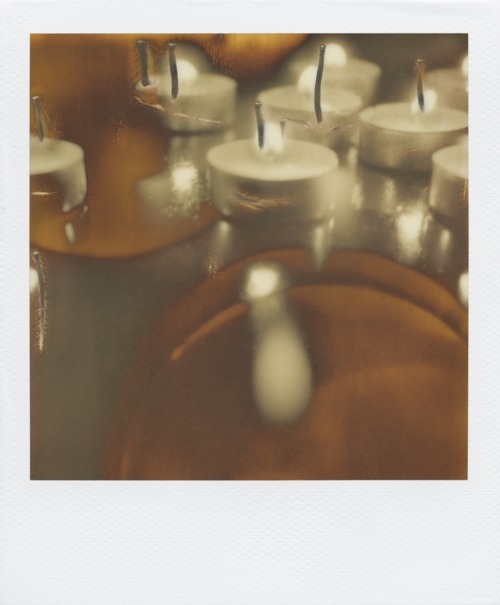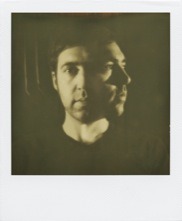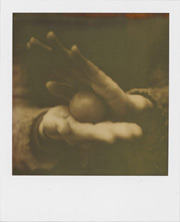on a black, white and grey night, last thursday i took myself into an environment which despite the colour references wasn’t the manchester weather. the north tea power, a quaint cafe in the northern quarter played host to the exhibition opening of the 'good grey'. consisting of the works from local photographers, the emphasis was on the medium of film used. in conjunction with the exhibit is the ‘impossible project’ whom provide the newly created analogue film that produces the results of an instant picture, the same way as the late polaroid did. the collection did much to show the romantic and creative elements analogue film has to offer and as i scanned around the walls of the instant artworks, i was intrigued to discover more about the ‘impossible project’. i caught up with the founder florian kaps, who was kind enough to enlighten me on the impossible journey they’ve had on reviving instant photography after the capitulation of polaroid. i found out what compelled the revival especially in the days of digitalisation, the impossibility in creating a whole new system for analogue film and how close we came to losing the photographic art form as a whole.
- what first attracted you towards analogue, especially in an age of digital takeover?
the smell of a polaroid camera that i stumbled over on a flea market and the unique, charming image it produced. it made me realized how attractive its tangible and sensitive characteristics are, and how rich in variety and exciting polaroid photos are compared to all those tons of perfect digital images.
- how and why did you decide to take action against the death of instant photography?
when polaroid announced in 2008 that they'd stop production of instant film i was devastated at first, but soon i realized that this is not the end but a beginning. but it was hard. tons of e-mails didn't get anything moving. it was not before the closing event of the factory in enschede, where I met andre bosman, a former polaroid production manager, who told me that the plant was still intact. together we decided to take action and to try the impossible. we preserved that plant, chose 10 former polaroid employees and started reinvention of a new instant film.
- did it take a while to realise that there was a mutual interest and a genuine market to revive analogue and create a new instant film?
we ran an online shop exclusively dedicated to analogue instant film and cameras (we were the only official polaroid online reseller back then) since 2005. during these years we saw a dramatically increase in customer's demand for instant film, so we knew that here was a market and interest for instant film out there.
- what was the most difficult task in the process of creating a new system?
the whole process! we had to find, create, produce and assemble 31 new components in a way that we'd get a working and stable film in the end. it truly was an impossible task, chances that we'd fail/succeed was 50/50.
- back in 2008 when you embarked on the project, did you initially declare it 'impossible', or was it looking back with hindsight to see the difficulties you overcame that you coined the name the 'impossible project'?
our name has several reasons: firstly our chance that we would succeed in producing a new film was 50/50. we never knew if this would be possible. so the chance of impossibility was always involved. secondly many people were telling us that this would be impossible. so our name is kind of a challenging reaction to all these dares. thirdly our name is based on a quotation by edwin h. land, the inventor of analogue instant photography and the founder of polaroid. as he was himself working on a quite impossible task in his days, he said: “don’t undertake a project unless it is manifestly important and nearly impossible”.

- looking at your website i notice there are numerous step by step guides, is this for people who are not so familiar with analogue or is it an attempt to ensure and maximize creative performance?
it is to explain people that impossible film is not (working like) polaroid film. it's a completely new film, and other than the highly standardized polaroid film it requires particular handling (most important is to immediately shield the image from light as the camera ejects it.) when following these few important points, our films will deliver breathtaking images with an iridescent tone range from black & white to sepia, depending on light conditions and temperature. the films also allow various artistic manipulation techniques.
- how does analogue film stand alongside the digital nature of photography, in a sense of a finished piece of art and the creative process as a whole?
analogue film teaches us to look at the world differently. we need to think before we press the button, because every single image costs you money. this value also has further significances embedded - every single image is unique, with unforeseeable characteristics and atmospheres. you can apply creative techniques to the image, you can give it to someone as a present, you can hide it in your diary - and you can declare it as a piece of art.
- i'm amazed by all the different techniques, for example, in manipulation and peeling. do you think the possibilities are endless for instant creativity?
YES!
- with the rising popularity of film cameras and also super8 motion film, do you think that impossible’s new instant film will benefit from revival?
yes. there is this certain analogue niche market - super 8, vinyl - and impossible film!
- i read on the site 'future is analogue.' what does the future hold for the impossible project?
further development and improvement of further, different film materials, further artistic projects & collaborations and possibly a new instant camera (we've now started research if and how a new analogue instant camera would be possible).
- finally, if the last polaroid factory wasn't saved and the project wasn't created, do you think people would have forgotten about instant photography?
well, sooner or later all existing polaroid cameras would have become obsolete, and sooner or later they would have end up in the trash, and sooner or later people would probably have forgotten about polaroid photography.


[fred paginton]




No comments:
Post a Comment